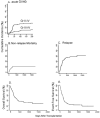Improved survival with inhibitory killer immunoglobulin receptor (KIR) gene mismatches and KIR haplotype B donors after nonmyeloablative, HLA-haploidentical bone marrow transplantation
- PMID: 19961944
- PMCID: PMC2848533
- DOI: 10.1016/j.bbmt.2009.11.022
Improved survival with inhibitory killer immunoglobulin receptor (KIR) gene mismatches and KIR haplotype B donors after nonmyeloablative, HLA-haploidentical bone marrow transplantation
Abstract
Natural killer (NK) cell alloreactivity, which may contribute to the graft-versus-leukemia (GVL) effect of allogeneic hematopoietic stem cell transplantation (HSCT), is influenced by the interaction of killer-cell immunoglobulin-like receptors (KIRs) on donor NK cells and their ligands, human leukocyte antigen (HLA) class I molecules on recipient antigen-presenting cells (APCs). Distinct models to predict NK cell alloreactivity differ in their incorporation of information from typing of recipient and donor KIR and HLA gene loci, which exist on different autosomes and are inherited independently as haplotypes. Individuals may differ in the inheritance of the 2 KIR haplotypes, A and B, or in the expression of individual KIR genes. Here, we examined the effect of KIR and HLA genotype, in both the recipient and donor, on the outcome of 86 patients with advanced hematologic malignancies who received nonmyeloablative (NMA), HLA-haploidentical HSCT with high-dose, posttransplantation cyclophosphamide (Cy). Compared to recipients of bone marrow (BM) from donors with identical KIR gene content, recipients of inhibitory KIR (iKIR) gene-mismatched BM had an improved overall survival (OS) (hazard ratio [HR]=0.37; confidence interval [CI]: 0.21-0.63; P=.0003), event-free survival (EFS) (HR=0.51; CI: 0.31-0.84; P=.01), and relapse rate (cause-specific HR, SDHR=0.53; CI: 0.31-0.93; P=.025). Patients homozygous for the KIR "A" haplotype, which encodes only 1 activating KIR, had an improved OS (HR=0.30; CI: 0.13-10.69; P=.004), EFS (HR=0.47; CI: 0.22-1.00; P=.05), and nonrelapse mortality (NRM; cause-specific HR=0.13; CI: 0.017-0.968; P=.046) if their donor expressed at least 1 KIR B haplotype that encodes several activating KIRs. Models that incorporated information from recipient HLA typing, with or without donor HLA typing, were not predictive of outcome in this patient cohort. Thus, NMA conditioning and T cell-replete, HLA-haploidentical HSCTs involving iKIR gene mismatches between donor and recipient, or KIR haplotype AA recipients of BM from KIR Bx donors, were associated with lower relapse and NRM and improved OS and EFS. These findings suggest that selection of donors based upon inhibitory KIR gene or haplotype incompatibility may be warranted.
Copyright (c) 2010 American Society for Blood and Marrow Transplantation. Published by Elsevier Inc. All rights reserved.
Figures






References
-
- Marsh SGE, Parham P, Dupont B, et al. Killer-cell Immunoglobulin-like Receptor (KIR) Nomenclature Report, 2002. Human Immunology. 2003;64:648–654. - PubMed
-
- Uhrberg M, Valiante NM, Shum BP, et al. Human Diversity in Killer Cell Inhibitory Receptor Genes. Immunity. 1997;7:753–763. - PubMed
-
- Shilling HG, Guethlein LA, Cheng NW, et al. Allelic Polymorphism Synergizes with Variable Gene Content to Individualize Human KIR Genotype. The Journal of Immunology. 2002;168:2307–2315. - PubMed
-
- Young NT. Immunobiology of natural killer lymphocytes in transplantation. Transplantation. 2004;78:1–6. - PubMed
Publication types
MeSH terms
Substances
Grants and funding
LinkOut - more resources
Full Text Sources
Other Literature Sources
Medical
Research Materials
Miscellaneous

